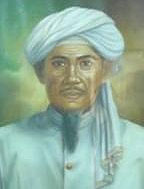The above statement was taken literally from Hang Tuah’s famous quotes “Takkan Melayu Hilang di Dunia" or "Malays will never vanish from the face of the earth". The quote is a famous rallying cry for Malay nationalism. Hang Tuah (Jawi:هڠ تواه) is the legendary Malay warrior who lived during the reign of Sultan Mansur Shah of the Sultanate of Malacca in the 15th century. He was the greatest of all the laksamana, or sultan's admirals, and was known to be a ferocious fighter. Hang Tuah is held in the highest regard, even in present-day Malaysian Malay culture, and is arguably the most well-known and illustrious warrior figure in Malaysian history and literature. From this famous quote, lets us explore the Malays that survive out of Malay territory.
 |
| A bronze mural of Hang Tuah with Ta' Melayu Hilang Di-Dunia written at the top. Exhibited at the National History Museum, Kuala Lumpur, Malaysia |
THE CAPE MALAY
Cape Malay community is an ethnic group or community in South Africa. It takes its name from the Western Cape in South Africa and they are Javanese from Maritime Southeast Asia now known as Indonesia and substantially some are Malays from Malacca~Dutch area. Members of the community are the archipelago slave sent by the Dutch East India Company. They were political dissidents and Muslim religious leaders who objected to the presence of the Dutch in Indonesia and the present exile. Beginning in 1654, the resistor is imprisoned or in exile in South Africa by the Dutch East India Company, who discovered and their present use Cape Town as a resupply station for ships traveling between Europe and Asia. The origins of this migration can be traced to early in the sixteenth century when, at the end of Indonesia's Majapahit Kingdom. They were the first who introduced Islam to South Africa. One prominent figure among the exiles, or Orang Cayen (Men of Repute), who resisted the Dutch occupation of the East Indies, was Sheikh Yusuf al-taj alkhalwatial-Maqasari. Credited with having brought Islam to South Africa, Sheikh Yusuf was born in 1626 in Goa on the island of Celebes (today known as Sulawesi).  |
| A potrait of Sheikh Yusuf |
Sheikh Yusuf was the son of Makassarese nobility, and the nephew of King Bissu of Goa. Sheikh Yusuf spent several years studying Arabic and traditional religious sciences in Mecca. He eventually returned to Banten, West Java, where he taught the Islamic doctrine of "Khalwatiyyah", which he had learned during his years spent in Mecca. He eventually joined forces with Sultan Ageng in his fight against the Dutch attempts to gain complete control of the Sultanates in the East Indies. In 1683, Sheikh Yusuf was captured and exiled to Ceylon and eventually brought to the Cape of Good Hope. On 2 April 1694, Sheikh Yusuf, together with 49 other Muslim exiles from the East Indies arrived at the Cape aboard the ship “de Voetboeg.”
 |
| Old pictures of Cape Malays at Cape Town |
Remnants of the old ‘Malay’ culture is still to be found in Cape Town today as a thriving Cape Malay community lends character to the mother city of South Africa. Cape Malay architecture, food (such as bobotie and yellow rice, samoosas, rotis, etc.), tailor shops, mosques and the warmth and hospitality of the Malay people continue to attract tourists in abundance to the mother city. Malaysians and Indonesians are starting to visit Cape Town in increasing numbers to experience this cultural link for themselves.






PICTURES OF MALAY CAPE
THE SRI LANKANS MALAYS
 |
| Sri Lankan Malays |
The Malays of Sri Lanka would have been a long forgotten minority, had they not maintained their mother tongue, the Malay at least in a colloquial form. The Malay community is a distinct ethnic group. They are Muslim by religion. The present population of Sri Lankan Malays counts only a 5% of the Muslim population, which is also an 8% of the whole population of Sri Lanka. Except for slight changes in numbers, the percentage of the Malay population remained unchanged. While the present number of Malay population stands at 60,000 persons, one third of them live in Colombo, others are scattered out in several districts of Sri Lanka. Among them, the largest number is 1% of the population of Hambantota district in the southern Sri Lanka.
 |
| Sri Lankan Malay Decendents |
The Malays of Sri Lanka has developed their own distinct features to an extent that Tunku Abdul Rahman, a former Prime Minister of Malaysia commented on the Sri Lankan Malays in the following:
“The only difference is that their features have changed. They look more like Indians than Malays and their language is strongly influenced by the Indian dialect. What's more they have lost touch with adat and custom, but still they call themselves Malays… But these (Malay) soldiers who went there without their womenfolk married into the families of the Indian Muslims. These Muslims were known as the Moors and after generations of intermarriages, it is hard to pick one from the other, Malays or the Moors, except when they themselves announce their racial identity…“ (Rahman 1983, 195).
However, there is no argument about the fact that the Malay language accorded a stronger support in forming the Malay community of its own outside Malay Peninsula and Indonesian archipelago.
 |
| M.T.M. Rihan, one of the many young people in the village of Kirinda who are educated but unemployed. Speaking Sri Lanka Malay, Sinhala, Tamil and English, he sometimes works as translator |










0 comments:
Post a Comment